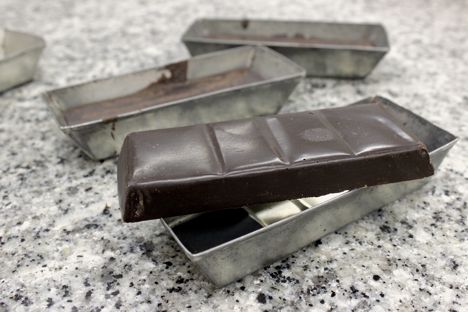
Modican chocolate: Sicily's ancient bar of cocoa
Luciana Squadrelli introduces us to Modican chocolate, a speciality found in Sicily that's made in the same way as the ancient chocolate of the Aztecs.
View more from this series:
Italy's regional cuisineSicily is one of Italy's most appreciated destinations. The triangle-shaped island has got it all: nature, sea, mountains (volcanoes included), history, art and – of course – food; from the ‘surf and turf’ traditional cuisine to the scrumptious sweet treats, which deserve a separate discussion. Arab influences, ancient monastic recipes and excellent local products such as ricotta, citrus, honey and almonds are at the heart of the acclaimed Sicilian cakes and pastries, such as cannoli, cassate and marzapane. All over the island it's easy to find this kind of cake, with the occasional subtle variations in the different areas. But you need to go to Modica to taste and experience the unique local chocolate, which descends from ancient Aztec traditions and recipes.
The breathtaking city, built between the rocky top of a hill (Modica Alta) and a deep canyon-like valley (Modica Bassa), is not only considered the capital of Sicilian Baroque architecture and part of UNESCO Heritage Sites along with the surrounding Val di Noto area. Modica is also the capital of Sicilian chocolate.
In the seventeenth century, the Spanish brought with them the tradition of eating exotic products imported from the Americas. Local noble families were happy to indulge, but it’s thanks to the nuns – who always prepared exquisite cakes and pastries in the seclusion of the cloistered convents of the islands – that the ancient recipe of Modican chocolate, with its peculiar taste and rough texture, has been handed down over the years.
Different from ‘modern’ chocolate, Modican chocolate is made without the conching process, which refines cocoa beans by roasting, grinding and liquefying them in a container called a conca, where metal beads grind and keep the chocolate mass, with cocoa butter added, in a liquid state, making it incredibly smooth. Instead, the beans are manually processed and ground in a traditional stone bowl called a metate.This is exactly how the Aztecs (and the Mexicans until the nineteenth century) made chocolate.
This ancient, precious tradition almost disappeared, but luckily enough some local craft confectioners rescued it and made Modican chocolate a world-renowned delicacy. Today there are many chocolate-makers in Modica, but the credit for saving it mainly goes to Franco and Pierpaolo Ruta, descendants of Francesco Bonajuto, who established a well-known pastry shop in Modica in 1880. In the early 1990s, when Pierpaolo's grandfather decided to shut down the shop, the young Sicilian and his father decided to take over from him. ‘We could not let it disappear, both the shop's history and the chocolate making,’ Pierpaolo says. ‘We were well aware of the value – both regarding taste and nutritional aspects – of this product, which had been described by the famous Sicilian author Leonardo Sciascia as ‘the archetype of chocolate’. We wanted to champion this ancient tradition which had become all but forgotten, so we invested in the Dolceria (pastry shop), renovating it to welcome visitors and show them what happens in the open-view laboratory, doing our best to spread the knowledge about this real piece of history.’ Their work was not in vain; today, they produce over twenty tons of chocolate every year, compared to the mere 200 kilos Pierpaolo's grandfather made.
Then and now
Chocolate-making in Modica has changed very little over the years, with the only main change coming in the 1960s; a specific piece of machinery that’s more like a grindstone instead of the manual grinding in the metate, called a valata ra ciucculatta. Roasted and ground cocoa bins are processed at temperatures under 50ºC, before sugar is added – which will not melt completely – with selected flavourings.
The thick and gritty mixture obtained after this process is then placed in special moulds, before being vigorously shaken and beaten on the worktop to perfectly model it into a bar, with rectangular sections to be detached to eat or for hot chocolate, indicating the ideal serving. Originally, the most popular way to enjoy Modican chocolate was in a hot drink, but later on people started to like the peculiar grainy texture gently scratching the palate when eaten as a block.
Flavouring Modican chocolate is also an old tradition. Initially, the only flavourings used were cinnamon and vanilla, and these are still amongst the most loved ones. But Pierpaolo and Franco Ruta – who were soon joined by other local artisans – started to experiment also with different Sicilian (and sometimes more exotic) products such as orange or marjoram, always used in their natural form. ‘These are ‘emotional’ flavours; the marjoram-flavoured bar we sell, for example, was born from a childhood memory of when my grandfather, coming back from the fields, entered the room where my grandmother was cooking chocolate and their smells met,’ says Pierpaolo.
Luciana Squadrelli
Today the Antica Dolceria Bonajuto, a cozy and fascinating shop looking over a courtyard right opposite the beautiful St. Peter's church in Modica Bassa, is a middle ground between a museum, pastry-shop and laboratory, with the old wooden furniture full of relics and utensils from the past and the shelves full of tempting delicacies. A real heaven for those with a sweet-tooth, the Dolceria does not only offer chocolate bars of different colours and kinds, but also other cornerstones of traditional Sicilian pastry; delicious cannoli which are filled before the customer's eyes with ricotta and chocolate cream before being decorated with pistachios, nucatoli (S-shaped biscuits filled with dried figs, almonds, honey and quince jelly), aranciata (a nougat-like sweet made of dried orange peel and honey) and the lesser-known 'mpanatigghi (biscuits filled with a mixture of meat and chocolate) directly descending from Spanish empanadillas.

